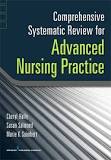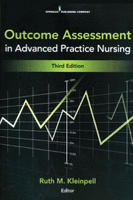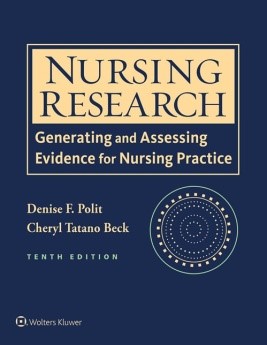| Course Number: | NR714 |
|---|---|
| Course Title: | Application of Analytic Methods II |
| Course Credits: | 3 (3, 0) |
| Prerequisite: | Prerequisites: NR700, 701 |
Syllabus
Overview
Course Description
The focus of this course is on comprehensive systematic review of evidence, including economic appraisal, statistical analysis, and outcome measurement and evaluation.
Clinical Compliance Requirements
Chamberlain does not have specific practicum compliance requirements for DNP students. Meeting student compliance requirements will only be necessary when the student’s practicum facility requires it. Students who do not complete the facility-specific requirements prior to the start of the course will not be registered or will be withdrawn from the course. Students should direct any questions to DNPPracticum@chamberlain.edu.
Textbooks and Resources
Required Textbooks
The following books are required for this course:
Holly, C., Salmond, S. W., & Saimbert, M. K. (2012). Comprehensive systematic review for advanced nursing practice. New York, NY: Springer Publishing Co. (ISBN: 978-0-8261-1778-6)
Kleinpell, R. M. (2013). Outcome assessment in advanced practice nursing (3rd ed.). New York, NY: Springer Publishing Co. (ISBN: 978-0-8261-1047-3)
Polit, D. F. & Beck, C. T. (2016). Nursing research: Generating and assessing evidence for nursing practice (10th ed.). Philadelphia, PA: Lippincott, Williams & Wilkins. (ISBN-13: 978-1-49630-023-2)
Sylvia, M., & Terhaar, M. (2014). Clinical analytics and data management for the DNP. New York, NY: Springer. (ISBN: 978-0-8261-2973-4)

American Psychological Association. (2010). Publication manual of the American Psychological Association (6th ed.). Washington, DC: Author. (ISBN-13: 978-1433805615)
Nelson, E. C., Batalden, P. B., & Godfrey, M. M. (2007). Quality by design: A clinical microsystems approach. San Francisco: Jossey-Bass. (ISBN: 978-0-7879-7898-3)
Optional Textbooks
The following books are required for this course:
Physical Books and Supplies
To obtain all your books and supplies, visit the online Chamberlain bookstore at https://bookstore.chamberlain.edu/.
eBook Details
First Time Using VitalSource?
Step 1: View the VitalSource Video
Step 2: Register with VitalSource Bookshelf Online
- Click the cover or title of your eBook. A new window will open.
- Enter email address and password. Bookshelf Online will open.
Step 3: Access the Desktop and Mobile Versions
You must complete Step 2 prior to using the desktop or mobile versions.
Already Registered? 3 Ways to Access Your eBooks

Online
Access your eBook by clicking on the book cover or title in the syllabus page. Bookshelf Online will open.

Desktop
Download your eBooks and use them whether you're connected to the Internet or not.

Mobile
Download the app and get your eBooks on your iPhone, iPad, or Android device.
Program Outcomes
The outcomes for the Doctor of Nursing Practice (DNP) degree program are as follows:
1
Apply biophysical, psychosocial, sociopolitical and cultural principles to integrative healthcare economics, nursing science and ethics in evidence-based advanced nursing practice to improve the nation\'s health through clinical prevention and population-focused healthcare (DNP Essentials VII, VIII).
2
Assume a leadership role as a DNP-prepared nurse in application, formation and reformation of health policy and advocacy in healthcare at micro, meso and macro levels (DNP Essentials V).
3
Synthesize scientific methods and underpinnings to develop best practices and shape informed healthcare decisions and systems of care for patient/family and populations to improve health or practice outcomes (DNP Essentials I, III).
4
Base advanced nursing practice on relationship-based practice and care delivery models that embrace political, ethical, professional, economic, socially just and culturally appropriate services in a variety of healthcare delivery settings (DNP Essentials VIII).
5
Integrate scientific-based theories and concepts that facilitate best practices in the nature and significance of health and healthcare delivery phenomena with strategies to improve healthcare delivery and outcomes, appreciating theory-based healthcare for evidence-based practice (DNP Essentials I, III).
6
Distinguish organizational and transformational leadership that fosters and promotes patient safety, integration of healthcare technology and informatics to improve patient safety and health or practice outcomes for quality improvement and systems thinking that improve and transform healthcare (DNP Essentials II, IV).
7
Assimilate concepts of healthcare technology and informatics to make data-driven decisions that inform advanced nursing practice and patient care systems that are nurse-sensitive and patient/family-and population focused (DNP Essentials IV).
8
Exercise interprofessional collaboration as a nursing role model for collegiality and professionalism in healthcare delivery settings to facilitate optimal care and patient outcomes that improve patient/family and population health or practice outcomes (DNP Essentials VI).
9
Analyze conceptual and analytical skills in evaluating links among practice, organization, population, fiscal and policy issues as a basis for transformational change in healthcare delivery systems (DNP Essentials V).
Course Outcomes
Chamberlain College of Nursing courses are built to align course content with specific Course Outcomes (COs). The COs define the learning objectives that the student will be required to comprehend and demonstrate by course completion. The COs that will be covered in detail each week can be found in the Overview page in that particular week. Whenever possible, a reference will be made from a particular assignment or discussion back to the CO that it emphasizes.
Upon completion of this course, the student will be able to do the following.
1
Formulate PICOT/PICoT questions relevant to advanced nursing practice (PO #3).
2
Utilize comprehensive systematic-review skills necessary for evidence-based practice (PO #5).
3
Critically appraise level and quality of evidence related to a selected advanced nursing practice issue (PO #3).
4
Compare and contrast differences and similarities with selected characteristics of qualitative, quantitative, and economic research designs (PO #3).
5
Evaluate appropriateness of a qualitative research design for a selected PICoT question (PO #3).
6
Evaluate appropriateness of a quantitative research design for a selected PICOT question (PO #3).
7
Evaluate appropriateness of an economic research design for a selected economic appraisal of evidence (PO #3).
8
Demonstrate understanding of mixed-method research and the strategy of triangulation design (PO #3).
9
Analyze qualitative, quantitative, and economic data for the purposes of critical appraisal of evidence (PO #3).
10
Evaluate selected statistical methods for the purposes of critical appraisal of evidence (PO #5).
11
Differentiate selected statistical methods for the purposes of evidence-based practice quality improvement (PO #5).
12
Demonstrate advanced nursing practice skills necessary for outcome assessment, measurement, and evaluation (PO #5).
Course Schedule
| Week, COs, and Topics | Readings | Assignments |
|---|---|---|
Week 1 COs 2 and 3 Comprehensive Systematic Review for Advanced Nursing Practice | Holly, C., Salmond, S. W., & Saimbert, M. K. (2012). Comprehensive systematic review for advanced nursing practice. New York, NY: Springer Publishing Co.
| Discussion Threads |
Week 2 COs 4, 5, and 6 Qualitative and Quantitative Research Methods and Analysis | Holly, C., Salmond, S. W., & Saimbert, M. K. (2012). Comprehensive systematic review for advanced nursing practice. New York, NY: Springer Publishing Co.
Polit, D. F. & Beck, C. T. (2016). Nursing research: Generating and assessing evidence for nursing practice (10th ed.). Philadelphia, PA: Lippincott, Williams & Wilkins.
Nelson, E. C., Batalden, P. B., & Godfrey, M. M. (2007). Quality by design: A clinical microsystems approach. San Francisco: Jossey-Bass.
| Discussion Threads |
Week 3 COs 4 and 7 Economic Research Methods and Appraisal | Holly, C., Salmond, S. W., & Saimbert, M. K. (2012). Comprehensive systematic review for advanced nursing practice. New York, NY: Springer Publishing Co.
Kleinpell, R. M. (2013). Outcome assessment in advanced practice nursing (3rd ed.). New York, NY: Springer Publishing Co.
| Discussion Threads |
Week 4 COs 2 and 3 The Need for Leveling and Grading of Evidence in Advanced Nursing Practice | Holly, C., Salmond, S. W., & Saimbert, M. K. (2012). Comprehensive systematic review for advanced nursing practice. New York, NY: Springer Publishing Co.
Polit, D. F. & Beck, C. T. (2016). Nursing research: Generating and assessing evidence for nursing practice (10th ed.). Philadelphia, PA: Lippincott, Williams & Wilkins.
| Discussion Threads |
Week 5 COs 8 and 9 Evaluating Power Analysis, Reliability versus Validity, and Mixed-Methods Research | Sylvia, M. & Terhaar, M (2014). Clinical analytics and data management for the DNP. New York: Springer Publishing Company.
Polit, D. F. & Beck, C. T. (2016). Nursing research: Generating and assessing evidence for nursing practice (10th ed.). Philadelphia, PA: Lippincott, Williams & Wilkins.
| Systematic and Integrative Review of Selected Clinical Question/Evidence Paper Discussion Threads |
Week 6 COs 9, 10, and 11 Differentiating Between Selected Statistical Methods for the Purpose of Critical Appraisal | Polit, D. F. & Beck, C. T. (2016). Nursing research: Generating and assessing evidence for nursing practice (10th ed.). Philadelphia, PA: Lippincott, Williams & Wilkins.
| Discussion Threads |
Week 7 COs 9, 10, and 11 Distinguishing Between Selected Statistical Methods for the Purposes of Evidence-Based Practice Quality Improvement | Polit, D. F. & Beck, C. T. (2016). Nursing research: Generating and assessing evidence for nursing practice (10th ed.). Philadelphia, PA: Lippincott, Williams & Wilkins.
| Statistical Analysis Module Project Discussion Threads |
Week 8 COs 1, 11, and 12 Outcome Assessment in Advanced Nursing Practice | Kleinpell, R. M. (2013). Outcome assessment in advanced practice nursing (3 rd ed.). New York, NY: Springer Publishing Co.
Sylvia, M. & Terhaar, M (2014). Clinical analytics and data management for the DNP. New York: Springer Publishing Company.
| You Decide Reflection One Discussion Thread All work must be complete by Wednesday, Week 8, 11:59 pm (MT). |
Turnitin
Students agree that, by taking this course, all work submitted for a grade is subject to submission for textual similarity review to Turnitin.com for the detection of plagiarism. All submitted papers will be included as source documents in the Turnitin.com reference database solely for the purpose of detecting plagiarism of such papers. Use of the Turnitin.com service is subject to the Terms and Conditions of Use posted on the Turnitin.com site.
Purpose:
The purpose of this Turnitin® policy is to facilitate the formative development of scholarly writing skills.
Overview:
Turnitin® is a web-based resource that Chamberlain College of Nursing makes available to students and faculty to comprehensively check written work to identify a similarity index for matching text with a database of existing written work, web pages, and electronic journals. Turnitin® assists students to identify potential plagiarism and supports the student toward academic integrity and originality in order to further develop their scholarly writing skills. Student assignments that are submitted to Turnitin® generate a Turnitin® Originality Report that students use to further edit their written work prior to submitting to faculty for feedback and evaluation.
Information about Turnitin® can be located in the Chamberlain School of Nursing Student Handbook. The link to Turnitin.com is placed in every online course under the “Course Home” tab, which is located at the bottom of the list.
Policy:
All faculty members teaching in the Doctor of Nursing Practice (DNP) program will use TurnItIn for each written assignment in all courses unless the syllabus states that a particular assignment is excluded. Additionally, all faculty will screen at least one complete discussion for plagiarism, using TurnItIn: This requirement must occur after the discussion has ended, but during the first four weeks of the course.
TurnItIn Excluded Assignments
The following assignments will be excluded from Turnitin for this course:
- Bullet point any assignment to be excluded
- Bullet point any assignment to be excluded
- Bullet point any assignment to be excluded
Late Assignment Policy
Students are expected to submit assignments by the time they are due. Assignments submitted after the due date and time will receive a deduction of 10% of the total points possible for that assignment for each day the assignment is late. Assignments will be accepted, with penalty as described, up to a maximum of three days late, after which point a zero will be recorded for the assignment.
In the event of an emergency that prevents timely submission of an assignment, students may petition their instructor for a waiver of the late submission grade reduction. The instructor will review the student’s rationale for the request and make a determination based on the merits of the student’s appeal. Consideration of the student’s total course performance to date will be a contributing factor in the determination. Students should continue to attend class, actively participate, and complete other assignments while the appeal is pending.
This Policy applies to assignments that contribute to the numerical calculation of the course letter grade.
Due Dates for Assignments and Exams
Unless otherwise specified, the following applies.
- Access to the course begins on Sunday at 12:01 a.m. (MT) during preview week.
- All assignments are to be submitted on or before Sunday at the end of the specified week that they are due by 11:59 p.m. (MT).
Note: In Week 8, the assignments would be due by Wednesday at 11:59 p.m. MT.
Evaluation Methods
The maximum score in this class is 1,000 points. The categories, which contribute to your final grade, are weighted as follows.
| Assignment | Points | Weighting |
|---|---|---|
| Discussion (25 points, per thread, Weeks 1–8) | 375 | 37.5% |
| Systematic and Integrative Review of Selected Clinical Question/Evidence Paper (Week 5) | 250 | 25% |
| Statistical Analysis Module Project (Week 7) | 275 | 27.5% |
| You Decide Reflection (Week 8) | 100 | 10% |
| Total Points | 1,000 | 100% |
| Letter Grade | Points | Percentage |
|---|---|---|
| A | 940–1,000 | 94% to 100% |
| A- | 920–939 | 92% to 93% |
| B+ | 890–919 | 89% to 91% |
| B | 860–889 | 86% to 88% |
| B- | 840–859 | 84% to 85% |
| C+ | 810–839 | 81% to 83% |
| C | 760–809 | 76% to 80% |
| F | 759 and below | 75% and below |
Participation for DNP
Professional Portfolio
Across the DNP program, you will collect assignments and compile them as artifacts within a Professional e-Portfolio to demonstrate your professional growth and expertise. Your final e-Portfolio, which will be submitted at the end of the degree program, will be assessed against the learning outcomes of the program. Chamberlain College of Nursing will provide detailed information regarding how and when to submit your Professional e-Portfolio in your final courses of the program. It is each student's responsibility to save and maintain all artifacts required in the e-Portfolio.
Be sure to save the following from this course:
- NR 714 Syllabus (copy)
- You Decide Reflection (Week 8)




